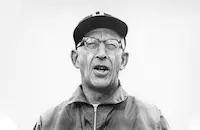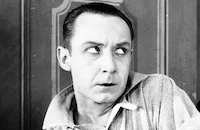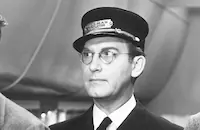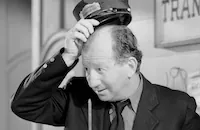Danger - Love at Work

Brief Synopsis
Cast & Crew
Otto Preminger
Ann Sothern
Jack Haley
Mary Boland
Edward Everett Horton
John Carradine
Film Details
Technical Specs

Synopsis
When Allan Duncan quits the law firm of Parsons, Hilton, Trent and MacMorrow, he tells the senior partners that the task they have given him is too difficult. Duncan's job was to obtain the signatures of the Pemberton family so that a piece of their land can be sold. The family members are very eccentric, however, and Duncan could not entice them to sign the required forms. J. B. Parsons and Hilton decide to give the case to Henry MacMorrow, a junior partner whom they believe has had too easy a life. Henry accepts the assignment and confidently states that if he does not succeed, Parsons can fire him. Henry boards a train bound for the Pemberton home in Aiken, South Carolina, and on the way, meets the youngest Pemberton, ten-year-old prodigy Junior, whose obnoxious behavior drives Henry to give him a kick in the pants at the Aiken station. Henry's rash action incurs the wrath of Junior's older sister Antoinette, whom the family calls Toni, and she does not let him explain. Henry reaches the Pemberton home first and is greeted by the other family members, who mistake him for Howard Rogers, Toni's latest fiancé. When Toni arrives, she explains that Henry is not Howard and, despite her earlier anger, grows to like Henry, who unwittingly leads her to believe that he is poor and the sole support of his widowed mother. Toni promises to help him, but her plans are foiled by the arrival of Howard, a very aggressive man who convinces the family that Henry must be a fake. Overwhelmed by the chaotic atmosphere, Henry flees home to New York City, where he is fired. In order to follow Henry, Toni convinces her family that their neighborhood is being quarantined, and they all go to New York. Toni finds Henry in Central Park and learns that he has lost his job. They obtain the signatures of Toni's family, then head to the countryside to get those of her Aunts Pitty and Patty and Uncle Goliath. While Toni and Henry are meeting with Pitty and Patty, Howard, still convinced that Henry is up to no good, assesses the Pemberton's land. Howard's car gets stuck in a stream and begins to leak oil, which Howard takes as evidence that the land is rich with oil. On the way back to New York, Henry and Toni are caught in a rainstorm and spend an innocent night in a nearby barn. The next day, Howard persuades the family to sell him their land for $125,000 and also convinces them that Henry, who is actually a millionaire, is a crook. Toni, who has fallen in love with Henry, is furious about his alleged deceptions and breaks off their relationship. Howard then learns from geologist McIlvane that the oil came from his car. The family has already spent his money, however, so he agrees to Junior's idea that he sell the land to Henry for $100,000. Toni then tries to call Henry, but he refuses to speak to her. Just then, Pitty and Patty arrive and reveal that Toni and Henry spent the night together in the barn. Seizing the opportunity, Toni acts as if she has been wronged, and the family insists that Henry be made to marry her immediately. They all rush over to his apartment, and Henry happily agrees to marry Toni.

Director

Otto Preminger
Cast

Ann Sothern

Jack Haley

Mary Boland

Edward Everett Horton

John Carradine

Walter Catlett
Bennie Bartlett
Maurice Cass

Alan Dinehart

Etienne Girardot

E. E. Clive
Margaret Mcwade
Margaret Seddon

Elisha Cook Jr.
Hilda Vaughn
Charles Coleman
George Chandler
Spencer Charters
Hal K. Dawson
Stanley Fields
Paul Hurst
Claude Allister

Jonathan Hale

Charles Lane
Paul Stanton

Franklin Pangborn
James Adamson
Sam Mcdaniel
Henry Roquemore
Gertrude Sutton

Marjorie Weaver
William Wagner
Guy Wilkerson
Roberta Vale

Emmett Vogan
Orville Caldwell
Jack Hatfield
Freeman Wood

Hank Mann
Crew
Joseph Aiken
Peter Arno
Lionel Bevans
Charles Bohny
M. Braggins
J. Burnett
Don Bush
David Buttolph
Gordon Cooper
Duncan Cramer
Earl Crowley
B. G. Desylva
Ed. Ebele
Mack Gordon
Duke Goux
John Grady
James Edward Grant
James Edward Grant
Fred Hall
Roger Heman
W. H. Leverett
Thomas Little
Roy Z. Lockridge
Ben Markson
Virgil Miller
Roger Murphy
Jack Murray
David Preston
T. L. Reed
Harry Revel
Irving Rosenberg
Abe Steinberg
Elsie Taylor
Don Wakeling
Gwen Wakeling
Walter Whaley
Harold Wilson
Darryl F. Zanuck

Film Details
Technical Specs

Articles
Danger - Love at Work
As a young man in Vienna, Preminger pursued a law degree, though he preferred appearing on stage, serving as a protégé to the legendary Max Reinhardt. By age 19, he had earned success as the manager of the Komedia Theater in Vienna, where he acted and worked as a producer-director. In 1932, he took over as manager of Reinhardt's Theater, the Josefstadt , after the great producer went into semi-retirement. The previous year, Preminger had directed his first film, Die Grosse Liebe, but it was his stage plays that secured his reputation. That reputation attracted the attention of Joseph Schenck, Chairman and Chief Executive Officer of 20th Century-Fox, while he was visiting Vienna. Schenck suggested that Preminger come to America because Fox was looking for new talent. When Broadway producer Gilbert Miller learned that Preminger was immigrating to America, he asked the young man to direct the courtroom drama Libel! The play closed five months later after the death of leading man Colin Clive, but by that time Preminger was already in Hollywood.
Fox's newest director got his feet wet with Under Your Spell (1936), a vehicle tailored to the singing talents of baritone Lawrence Tibbett, before his promotion to A-pictures with Danger--Love at Work. The script was based on the unpublished story "Marry an Orphan" by James Edward Grant, which Fox purchased from Universal for $15,000 and the loan of Alice Faye. The story follows successful lawyer Henry MacMorrow, who crosses paths with a family of wealthy eccentrics, the Pembertons. Henry's law firm needs the signatures of the entire Pemberton clan to complete the sale of one of their properties. The family includes Mr. and Mrs. Pemberton, an artist son named Herbert, a genius son named Junior, two maiden aunts, a cave-dwelling uncle, a bachelor uncle, and a beautiful but flighty daughter named Toni. Toni is engaged to the insufferable Howard Rogers, but she is immediately smitten with Henry.
Current descriptions of Danger--Love at Work often refer to it as a screwball comedy, undoubtedly due to the crazy antics of the characters, but it lacks most of the conventions of that genre. Toni and Henry are opposites in personality, which is typical of screwball comedies, but none of the other conventions are evident. The romance structures the narrative but does not propel it. The story does not include a clash of social classes, and the dialogue exchanges between Toni and Henry is devoid of the sexual tension generally found in screwball. As Toni, Ann Sothern is appropriately scatter-brained, not unlike Carole Lombard in My Man Godfrey (1936) or Katharine Hepburn in Bringing Up Baby (1938), but Jack Haley as Henry lacks the romantic appeal of Cary Grant, William Powell, or Clark Gable.
Instead, it is the Pemberton family that dominates the film. No extensive rationale is given for their eccentricities beyond a reference to the influence of Grandfather Pemberton who advocated free expression of personality without inhibitions. Eccentric wealthy families were a common convention of comedies during the Depression as the public struggled with the widening economic gap between the social classes. The wealthy characters' incompetence, lack of compassion, or lack of common sense deflated them, reducing their economic and class superiority in the eyes of average viewers. In Danger--Love at Work, the Pembertons are zany and ineffective but also lovable, and their class is not an issue in the storyline. Mary Boland, who specialized in playing madcap matrons and zany grande dames, steals her scenes as the fluttery Alice Pemberton. Mrs. Pemberton repeatedly mistakes Henry for someone else, devising elaborate explanations for why he simply must be who she thinks he is rather than who he actually is. At first she mistakes him for Howard Rogers, whisking him away to a guest room despite his protests that he is Henry MacMorrow. Later, she insists that he is a friend of the Evans' "who rescued poor Togo" while crossing the Atlantic on the Normandie. Mrs. Pemberton blurts out the entire story of Togo before Henry makes it clear that she is mistaken, only to have her huff that it is Henry who is eccentric, a lunatic, and crazy.
John Carradine plays her artist son Herbert, who is clearly intended as a satire of Salvador Dali. When Henry meets Herbert, he is decked out in a smock painting on the living room window. He is quite pleased with his modernist painting, dubbed "The Love Life of a Cup and Saucer," and announces that he is no longer a surrealist, but a post-surrealist. Later, Henry watches Herbert in action as he furiously paints a seascape while standing in front of a giant fan in a raincoat. A butler pours water on his head from a sprinkler, because, according to Herbert, the artist must experience the subject matter.
Other Pembertons include Albert (Etienne Girardot) and Junior (Benny Bartlett), an elderly father and young son who compete with each other for scientific breakthroughs to win the Nobel Prize. Two spinster aunts, Aunt Pitty (Margaret Seddon) and Aunt Patty (Margaret McWade), live in upstate New York near Uncle Goliath (Maurice Cass), who has eschewed the life of a wealthy socialite in order to return to nature. Dressed in animal skins, Uncle Goliath kills his own food with a club and dwells in a nearby cave. The Pemberton servants are as peculiar as the family: The chauffeur (Hal K. Dawson) repeatedly misses picking up people at the airport or train station because he can't resist the triple feature at the local movie theater. His favorite is the Mickey Mouse cartoons, which he recounts in great detail as family members laugh along with him.
The audience sees the Pembertons through the perspective of the "normal" characters--protagonist Henry MacMorrow and antagonist Howard Rogers, played by Edward Everett Horton. This device helps the audience see the family as unconventional, though Henry grows to accept their peculiarities while Howard is either exasperated by them or tries to exploit them.
The stage experience of the principal actors and director Preminger contributed enormously to the success of the film. From the first scene, in which Henry is assigned the task of tracking down the signatures of the Pembertons, the style of the film is set. The humor is dependent on the rapid-fire, well-timed delivery of dialogue. The actors speak quickly in a rhythm that accentuates certain words so that they are clear and easy to comprehend. Barely a beat separates the dialogue of the different characters. Scenes are dominated by medium long shots to accommodate the interaction of the ensemble cast. It is the snappy dialogue that propels the pace of the film, not the editing. Comedies with rapid-fire dialogue were in vogue at the time, epitomized by the screwball comedies of Howard Hawks (Bringing Up Baby; His Girl Friday, 1940), so Danger--Love at Work is nothing revolutionary. But, the ability of the actors--most of whom had extensive stage experience--to handle the pace of the dialogue combined with Preminger's staging and direction definitely elevate the material.
Originally, Fox president and executive producer Darryl F. Zanuck cast French actress Simone Simon in the role of Toni Pemberton. Preminger disagreed with the casting, telling Zanuck that the actress would not be able to handle the dialogue. The producer, who was notorious for his inability to take constructive criticism, insisted Simon would be just fine. After he saw the first rushes, Zanuck realized his mistake but blamed it on Simon, telling her she should go back to France because she was untalented. It was not a lack of talent that was her problem; it was her heavy accent, which prevented her from delivering the lines quickly and clearly with the required "snap," as Preminger called it.
Danger--Love at Work received good reviews, with critics rightfully crediting the terrific cast, brisk pace, and farcical tone for its sense of fun.
Producer: Harold Wilson
Director: Otto Preminger
Screenplay: James Edward Grant, Ben Markson, and Buddy G. DeSylva (uncredited), based on the story "Marry an Orphan" by Grant
Cinematography: Virgil Miller
Editor: Jack Murray
Art Director: Duncan Cramer
Costume Designer: Gwen Wakeling
Cast: Henry MacMorrow (Jack Haley), Antoinette "Toni" Pemberton (Ann Sothern), Alice Pemberton (Mary Boland), Herbert Pemberton (John Carradine), Howard Rogers (Edward Everett Horton), Uncle Alan (Walter Catlett), Albert Pemberton (Etienne Girardot), Junior Pemberton (Benny Bartlett), Uncle Goliath (Maurice Cass), Alan Dinehart (Allan Duncan), E.E. Clive (Wilbur), Margaret McWade (Aunt Patty), Margaret Seddon (Aunt Pitty), Chauffeur (Hal K. Dawson ), Chemist (Elisha Cook, Jr.), Henry's Valet (Charles Coleman), Maid (Hilda Vaughn).
BW-81m.
by Susan Doll

Danger - Love at Work
Quotes
Trivia
Notes
The plot summary for this film was based on a screen continuity contained in the Twentieth Century-Fox Produced Scripts Collection, and the onscreen credits were taken from a screen billing sheet in the Twentieth Century-Fox Records of the Legal Department, both of which are located at the UCLA Theater Arts Library. According to the legal records, Twentieth Century-Fox purchased James Edward Grant's unpublished, uncopyrighted story entitled "Marry an Orphan" from Universal. While Universal owned the story, B. G. DeSylva had worked on adapting it for the screen. Fox paid $15,000 for the story and agreed to loan Alice Faye to Universal to appear in their picture, You're a Sweetheart (see below). A March 1937 Hollywood Reporter news item noted that when DeSylva was working on the story for Universal, he hoped that it would star Carole Lombard and be directed by Gregory LaCava. According to Hollywood Reporter news items and production charts, the film started production with Simone Simon playing "Toni Pemberton." Shortly after filming began, she was replaced by Ann Sothern, who was borrowed from RKO. In exchange for Sothern's services, Twentieth Century-Fox agreed to loan Victor McLaglen to RKO. According to director Otto Preminger's autobiography, he objected to Simon taking the part because of her heavy French accent. Preminger also states that Twentieth Century-Fox executive Darryl F. Zanuck removed Simon after viewing early rushes because he was displeased with her performance. Peter Arno, who painted the paintings that appear in the film, was a well-known New Yorker cartoonist. According to the legal records, Arno was to supply the studio with three "Surrealistic" paintings, one each for the ceiling, a window and the bath. Actresses Margaret McWade and Margaret Seddon played similar roles in the 1936 Columbia film Mr. Deeds Goes to Town (see below). The Variety reviewer noted this picture's similarity to the play You Can't Take It with You, which was filmed by Columbia in 1938 (see below).














